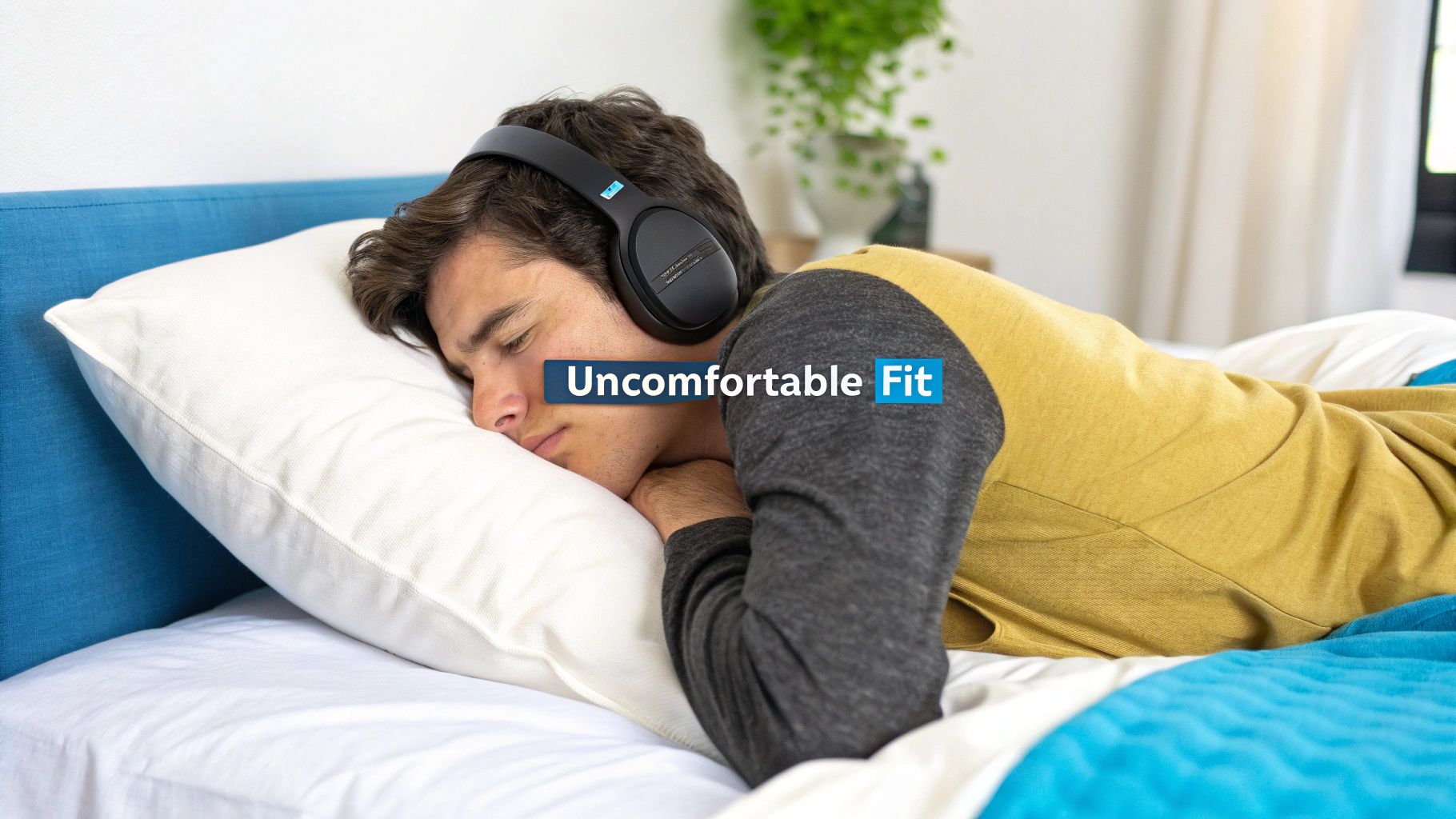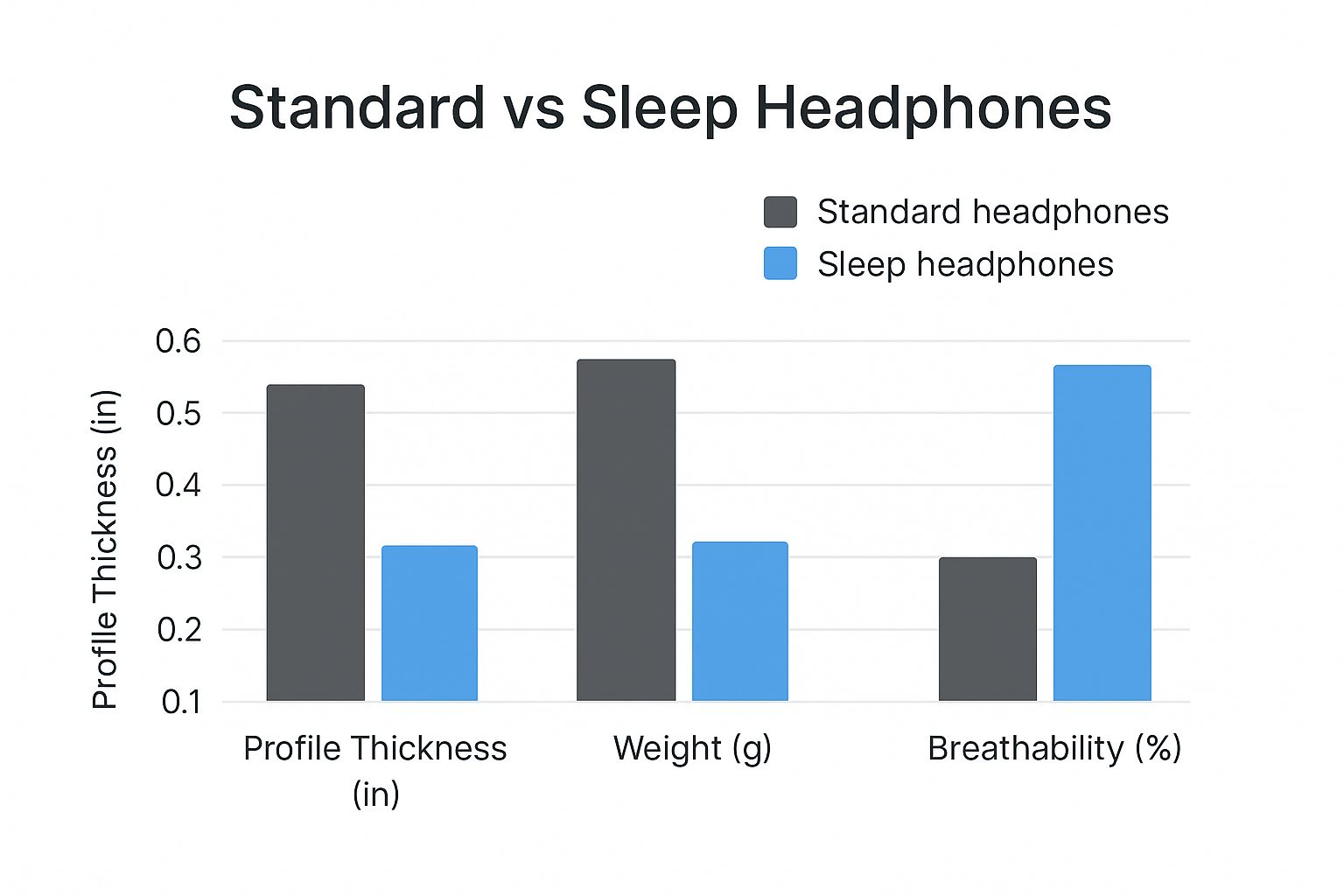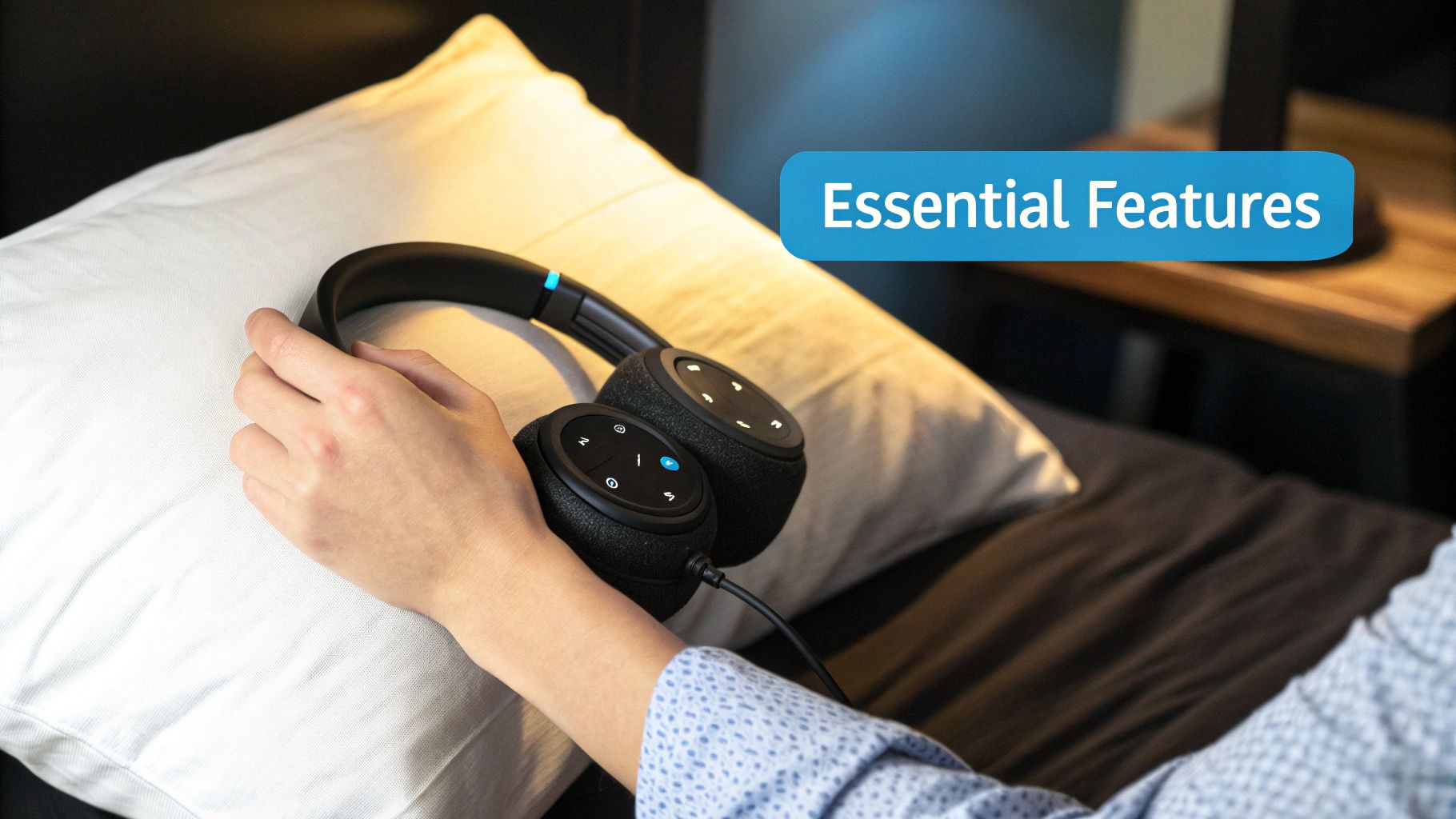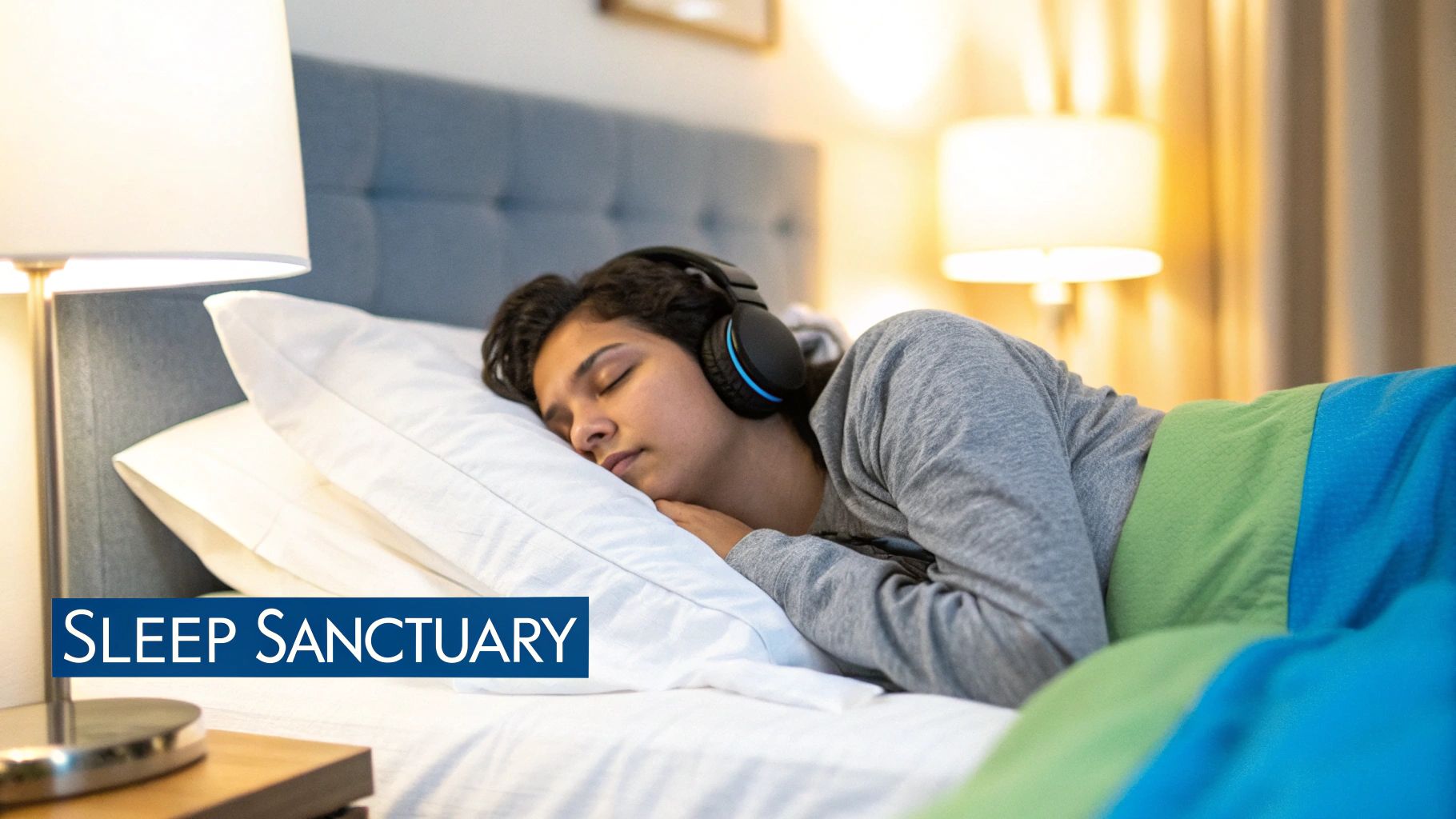If you've ever tried to drift off to sleep with a pair of bulky headphones digging into your ear, you know the struggle. It's a special kind of torture. Finding headphones that are actually comfortable for bed means you have to ditch your everyday pair for something built specifically with side-sleeping in mind.
The best sleep headphones are usually ultra-thin, lightweight, and flexible. The goal is for them to practically disappear once your head hits the pillow.
Why Regular Headphones Fail in Bed
Let's be real—trying to sleep with standard headphones is just asking for a frustrating night. You get comfortable, cue up your favorite podcast, roll onto your side, and… ouch. A hard piece of plastic painfully reminds you it's there. It’s an almost universal experience for anyone who likes to listen to something as they fall asleep.

This isn't really a design flaw in your headphones; it's a context flaw. Your fancy over-ear cans or your trusty gym earbuds were built for being upright and active. They were never meant to handle the full pressure of your head smooshing them into a pillow.
The Common Pain Points
The main issue boils down to a few key problems that make traditional headphones a non-starter for sleep. If you've tried it, you'll recognize these immediately:
- Intense Ear Pressure: Both over-ear cups and in-ear buds create sharp pressure points, which is a nightmare for side sleepers. This can leave your ears sore and completely ruin any chance of sleep.
- Bulky and Unstable Design: Big headbands slip and slide around, and earbuds have a knack for popping out the second you shift your weight.
- Cable Catastrophe: Wires are the worst. They tangle, wrap around your neck, and get caught in your bedding, which is not just annoying but also a potential safety issue.
This widespread need for a better solution has caused some serious market growth. Back in 2025, the global headphone market was valued at a whopping $15,080 million. A big driver for that growth is the demand for wireless models that offer more freedom for activities like sleeping. You can dig into industry reports to see all the trends pushing this forward.
A Different Design Philosophy Is Needed
Simply put, everything that makes headphones great for the daytime makes them terrible for the nighttime. Heavy bass, total noise cancellation, and a super-snug fit for your morning run become liabilities when you're just trying to peacefully drift off.
You wouldn't wear hiking boots to bed, right? Same logic.
The search for comfortable headphones for bed isn't about finding a softer version of regular headphones. It's about embracing a completely different approach to audio design—one where a low profile, flexibility, and minimal presence are the most important features.
This is exactly why a dedicated category of "sleep headphones" even exists. These products are engineered from the ground up to solve the unique puzzle of listening to audio while lying down. They're designed to have a barely-there feel, letting you focus on your podcast or music, not the hardware delivering it.
For more on this, check out our guide on how to sleep with headphones for some extra tips and tricks.
The Blueprint for All-Night Comfort
What exactly turns a normal pair of headphones into something you can actually sleep in all night? It’s not just one feature; it’s a whole design philosophy where comfort is the absolute priority. The hunt for genuinely comfortable headphones for bed really boils down to three core ideas: profile, weight, and materials.
Think about it like picking a pillow. You wouldn’t try to sleep on a hard, bulky rock, no matter how cool it looked. The same logic applies here. The single most important factor is an ultra-slim profile. This is non-negotiable. It’s what stops that sharp, digging pain in your ear when you roll onto your side, preventing those awful pressure points that jolt you awake.
There are a couple of ways designers tackle this. Some headphones embed tiny, flat speakers into a soft, stretchy headband. Others, like our Bedphones, take a different route, perfecting an on-ear design with incredibly thin, flexible speaker pads that rest gently on the ear, almost vanishing against the pillow.
Going Beyond a Slim Design
While being thin is the main event, it's only part of the story for true all-night comfort. The overall weight and the materials used are just as important for creating that "I forgot I was wearing them" feeling.
-
Lightweight Construction: Heavy headphones are a recipe for disaster over eight hours. They create a constant, noticeable pressure and can even lead to neck strain. The best sleep headphones feel feather-light. For some context, many popular over-ear headphones weigh over 250 grams. Specialized sleep models aim to be a tiny fraction of that. The goal is simple: you shouldn't feel them.
-
Breathable Materials: We’ve all experienced the hot, sweaty ears that come from wearing standard headphones for too long. That’s usually thanks to leather or plastic earcups that trap heat and moisture. For sleeping, that’s a deal-breaker. Breathable fabrics and soft foam padding are essential. They let air circulate, keeping your ears cool and comfortable and preventing you from waking up in a sweat.
This chart really drives the point home, showing just how different sleep-specific headphones are from their daytime cousins.

The numbers don't lie. Sleep headphones are engineered from the ground up to be dramatically thinner, lighter, and more breathable. They’re a direct solution to the biggest comfort problems you face when trying to listen to audio in bed.
The Synergy of Sleep-Centric Elements
These three elements—slim profile, low weight, and breathable materials—don't just work on their own. They combine to create an experience that finally makes all-night listening a real possibility. The slim profile gets rid of the pressure, the lightweight build removes the feeling of wearing a device, and the right materials keep you physically comfortable for hours on end.
When every design choice prioritizes a low physical presence, the technology fades into the background. This allows your mind to focus on the calming audio, not on the hardware delivering it, which is the ultimate goal for any sleep aid.
In the end, the blueprint for comfortable sleep headphones is a masterclass in minimalism. It’s about stripping away every single point of friction—both literally and figuratively—that stands between you and a peaceful night’s rest. When you focus on these core design pillars, you can finally find a pair that helps your journey to sleep instead of getting in the way.
Essential Features For Sleep Headphones
A slim profile and a lightweight feel are a great start, but the very best comfortable headphones for bed really shine because of their technology. It’s the smart features that separate a true sleep aid from just another nighttime gadget. We're talking about more than just physical shape; it's about how the headphones perform when you need them most—in the quiet of your room, when you're halfway to dreamland.

Picture this: you're finally drifting off, only to be yanked back to consciousness by a loud "BATTERY LOW" announcement. It’s the worst. This is exactly why reliable, long-lasting battery life is a deal-breaker. A solid pair of sleep headphones should last the entire night, no questions asked. Look for something that offers 10-12 hours of continuous playtime on a single charge. Anything less is just asking for an interruption.
In that same vein, fumbling with tiny, complicated buttons in the dark is beyond frustrating. Simple, tactile controls are an absolute must. You should be able to adjust the volume or skip to the next track purely by feel, without having to blind yourself with your phone screen. Large, easy-to-find buttons make all the difference.
Sound That Soothes, Not Startles
When it comes to audio for sleep, bigger and boomier is not better. The thumping bass and sharp treble that get you pumped up at the gym can be seriously jarring when you're trying to wind down. Instead, you want headphones with a balanced audio profile that’s been specifically tuned for the kind of content that helps you relax.
- Clarity for Spoken Word: The audio needs to be crisp and clear for podcasts, audiobooks, and guided meditations, without any muddy bass getting in the way.
- Richness for Ambient Noise: For white noise or nature sounds, the headphones should reproduce a full, gentle soundscape that effectively masks disturbances without introducing any harsh, distracting frequencies.
A Quick Guide to Bedtime Headphone Features
To make it easier to see what really matters, here’s a quick breakdown of what to look for in a great pair of sleep headphones compared to your everyday pair.
Essential Features for Comfortable Bed Headphones
| Feature | Ideal for Sleep Headphones | Why It Matters for Bedtime |
|---|---|---|
| Battery Life | 10-12+ hours of continuous playback. | Lasts the entire night without a "battery low" warning waking you up. |
| Controls | Large, simple, tactile buttons. | Allows for easy adjustments in the dark without needing to look at a screen. |
| Audio Profile | Balanced, clear mids, and gentle lows. | Perfect for spoken word and ambient sounds; avoids startling bass or treble. |
| Noise Handling | Passive noise isolation. | Gently muffles background sounds without the ear pressure of ANC. |
| Design | Ultra-thin, soft, and flexible materials. | Prevents ear pain and discomfort, especially for side sleepers. |
These features create an experience that’s designed from the ground up to help you rest, not just listen to audio.
The Great Debate: Noise Isolation vs. Cancellation
Finally, let’s clear up how sleep headphones should handle the noise from the outside world. This is a point of confusion for a lot of people because it involves two very different technologies.
Active Noise Cancellation (ANC) is a cool piece of tech that uses microphones to listen for external sounds and then creates an opposite signal to cancel them out. While it's fantastic for airplanes, it can sometimes create an odd feeling of pressure in the ears and it’s a major battery hog. For some people, that sensation alone is distracting enough to keep them awake.
Passive Noise Isolation, on the other hand, is much simpler. It physically blocks sound just by the nature of its design—think of it as gentle, targeted sound-muffling. For sleep, this is almost always the better choice. It effectively dulls background noises like snoring or distant traffic without that pressurized feeling, and it keeps you just aware enough to hear important things like a smoke alarm.
A gentle seal that reduces distractions without complete sensory deprivation creates a calmer, more natural sleep environment. It's about lowering the volume of the world, not muting it entirely.
By keeping an eye out for these core features—long battery life, simple controls, balanced sound, and gentle noise isolation—you'll be well on your way to finding headphones that genuinely improve your rest. For a closer look at how different models compare, check out our in-depth sleep headphones review.
How DubsLabs Bedphones Mastered Comfort
Understanding the theory behind sleep-friendly design is one thing, but seeing it done right is something else entirely. For a masterclass in engineering for nighttime comfort, look no further than DubsLabs Bedphones. Instead of trying to force a regular headphone to work for sleep, Bedphones were built from the ground up with one mission: create headphones so comfortable you completely forget you're wearing them.
The secret sauce is their unique on-ear design, which goes straight to the heart of the biggest problem for side sleepers—pressure. The speakers are the real stars of the show. They're astonishingly thin, measuring less than 1/4 inch thick, and wrapped in soft, squishy foam padding.
Picture the difference between resting your head on a hard book versus a thin sheet of memory foam. That's the kind of leap in comfort Bedphones offer. This ridiculously slim profile means that when you roll onto your side, the speaker compresses almost perfectly flat against your ear. There's no hard plastic digging in, creating those painful pressure points you get from earbuds and bulky over-ear cans.
Engineering a Weightless Fit
It's not just about being thin, though. The fit itself was painstakingly designed to feel secure yet barely there. This is where the brilliant infinitely adjustable memory wire ear hooks come in.
Think of them like a custom-molded frame just for your ears. The wire is flexible, allowing you to shape the hook perfectly to your ear's unique curves. The result is a stable fit that won't slip or fall off, no matter how much you toss and turn.
This approach brings a few huge advantages to the table:
- Feather-Light Feel: The entire setup is incredibly lightweight, getting rid of that clunky, heavy feeling you get with other gear.
- Secure Placement: Unlike earbuds that pop out or headbands that slide around, these ear hooks keep the speakers gently but firmly in place all night long.
- No Headband Pressure: By ditching the traditional headband, Bedphones eliminate the constriction and heat buildup that plague sleep headbands.
The design philosophy is crystal clear: true comfort comes from removing every possible point of physical resistance. From the flat speaker to the custom-fit wire, each element works together to make the headphones fade into the background.
A Superior Alternative for Sleep
When you break it all down, it’s obvious why Bedphones are so effective. They aren't just another product trying to jump on the sleep headphone bandwagon; they are a thoughtful, focused solution to a very specific set of problems.
The on-ear style hits the perfect sweet spot. It avoids the invasive, sometimes painful feeling of in-ear buds while completely sidestepping the bulk and heat of over-ear cups or fabric headbands. It's a testament to what's possible when you focus on the user's primary need—uninterrupted comfort for side sleepers. This is what smart engineering for a peaceful night's sleep looks like.
Using Audio to Enhance Your Sleep Quality
Finding a pair of physically comfortable headphones for bed is the first big hurdle, but the real magic happens when you start using them to get better, more restorative sleep. Once you have the right tool for the job, you can start building a personal sleep sanctuary, totally insulated from the outside world. This is where audio content becomes a powerful ally against all those common sleep disruptors.

Think of your headphones as a gentle shield. They can effectively mask those inconsistent, jarring noises—like a partner’s snoring, a neighbor's late-night TV, or passing traffic—by replacing them with a constant, soothing soundscape. This creates a stable auditory environment, which stops your brain from getting jolted awake by sudden sounds.
Curating Your Ideal Sleep Soundtrack
The beauty of using audio for sleep is its versatility. You get to tailor your listening experience to whatever helps your mind unwind. For many, this is a fantastic opportunity to ditch the blue light from screens, which is notorious for messing with melatonin production and your natural sleep cycle.
Instead of scrolling through your phone, you can try something new:
- Guided Meditations: These audio tracks are designed specifically to calm a racing mind. They often focus on breathing exercises and mindfulness to gently guide you toward sleep.
- Ambient Soundscapes: From gentle rain to the low hum of a fan, these sounds provide a consistent backdrop that does an amazing job of masking external noises.
- Engaging Audiobooks: Sometimes a captivating story is the perfect distraction from daily worries, allowing your body to relax while your mind is pleasantly occupied.
If you're looking for a place to start, a guided meditation audio book can be an incredibly valuable resource for getting into the habit.
Building a Better Bedtime Routine
Creating a dedicated sleep playlist or having your go-to audio ready can become a powerful sleep cue over time. Your brain starts to associate these specific sounds with winding down, making the transition to sleep smoother and more automatic each night.
This growing trend is a key reason the headphone market is evolving so quickly. The global earphone and headphone market, valued at USD 91.81 billion in 2025, is projected to rocket to USD 209.39 billion by 2032. This explosive growth is fueled by our preference for features like wireless convenience and noise-blocking—features that are perfect for bedtime use.
The right audio doesn't just block out noise; it actively helps quiet the internal chatter that so often keeps us awake. It gives your mind a peaceful place to focus, making it easier to let go of the day's stress and drift off.
To get started, try exploring apps that specialize in sleep-focused content. Many offer expertly curated playlists, stories, and soundscapes designed to help you fall asleep faster and stay asleep longer. If you need a little inspiration, check out our guide on deep sleep music and what to listen to.
Got Questions About Sleep Headphones? Let's Clear a Few Things Up.
Even after you've landed on what seems like the perfect pair of comfortable headphones for bed, it's totally normal to have some questions. For most of us, wearing any kind of tech all night is a new idea, so it makes sense to wonder about the practical side of things—like safety, cleanliness, and whether they actually work.
Let's walk through some of the most common concerns. My goal is to give you the confidence to build a nighttime listening routine that truly works for you.
"Are They Actually Safe to Wear All Night?"
This is probably the biggest question on everyone's mind. The short answer? Yes, absolutely—as long as you're smart about it.
The main thing to watch is the volume. You're not trying to blast a concert in your ears, you're trying to create a soothing backdrop for sleep. Listening to audio at a low-to-moderate level is perfectly safe for hours on end. Most smartphones even have a built-in volume limiter you can set, which is a great way to prevent any accidental loudness spikes while you're drifting off.
The other piece of the puzzle is the cord, if you go with a wired pair. It’s a simple fix: just run the cable down your back or away from your body. This keeps it well out of the way and removes any chance of it getting tangled around your neck. A tiny adjustment for a completely safe experience.
"What About Ear Health and Hygiene?"
Okay, so they're safe, but is it healthy to have something on your ears all night? People worry about things like ear infections or wax buildup, and those are valid points. But with the right kind of headphones, it's not really an issue.
The problem often comes from in-ear buds that create a seal in your ear canal. That can trap moisture and heat, which isn't great. On-ear styles, like Bedphones, are a different story. They rest gently on the outside of your ear, allowing air to circulate. That simple design choice makes a huge difference and dramatically lowers the risk of any moisture-related problems.
Of course, good hygiene is still key. Think about it—you wash your pillowcases, right? Your headphones deserve the same attention. Most sleep headphones have removable foam or fabric covers that you can wash. A quick wipe-down every few days will keep them fresh and clean.
"But What If They Fall Off While I'm Sleeping?"
It happens. You get comfortable, your podcast lulls you to sleep, and you wake up to find your headphones tangled in the sheets. Is that a problem?
Not at all. In fact, think of it as a win. If your headphones fall off, it just means they did their job! Your body reached a deep enough state of relaxation that it no longer needed the audio to stay asleep.
The whole point of using them is to help you unwind and cross the finish line into sleep. If they come off after that mission is accomplished, great! For those who toss and turn a lot, headphones with a more secure design, like ones with soft, adjustable ear hooks, are much less likely to go wandering in the night.
Ultimately, sleep headphones are just a tool. The goal is to create a peaceful bubble that helps you drift off. By understanding how to use them safely and cleanly, you can make them an incredibly effective part of your sleep toolkit.
Ready to feel the difference a true sleep-first design can make? See how DubsLabs engineered Bedphones for incredible all-night comfort and finally get the rest you've been dreaming of.
Explore Bedphones and other sleep-enhancing products on the DubsLabs website.











































